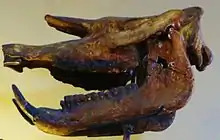Aceratherium
Aceratherium (Greek: "without (a) horn" (keratos), "beast" (therion)[2]) was a genus of rhinoceros of the subfamily Aceratheriinae that lived in Eurasia during the Miocene.
| Aceratherium Temporal range: | |
|---|---|
 | |
| A. incisivum skull | |
| Scientific classification | |
| Domain: | Eukaryota |
| Kingdom: | Animalia |
| Phylum: | Chordata |
| Class: | Mammalia |
| Order: | Perissodactyla |
| Family: | Rhinocerotidae |
| Subfamily: | †Aceratheriinae |
| Genus: | †Aceratherium Kaup, 1832 |
| Type species | |
| †Aceratherium incisivum Cuvier, 1822 | |
| Species | |
Taxonomy

Aceratherium was coined by Kaup (1832) for "Rhinoceros" incisivum Cuvier, 1822 on the basis of the similarity of two skulls from Eppelsheim, Germany to the holotype incisor tooth from Weisenau in dental structure.[3] However, the tooth from Weisenau has been recognized as belonging to a member of Teleoceratini, although the name Aceratherium has been widely used for the Eppelsheim skulls.[4] Traditionally, many species have been referred to Aceratherium on the basis of them being hornless, turning the genus into a wastebasket. Revisions over the years have removed most species to the point that there are now only three valid species generally recognized (A. incisivum, A. depereti, and A. porpani).
Description
Aceratherium reached 2.3 m (7 ft 7 in) in length, a height of about 120 cm (47 in) and a weight of nearly 1 ton.[5] Its brachyodont dentition suggest it was a browser which fed on leaves and soft vegetables. It had fairly long limbs compared to other Aceratheriinae, and was proportioned similar to a tapir. Males had tusk-like incisors that were much larger than those of the females.[6]
References
- Tao Deng; Rattanaphorn Hanta & Pratueng Jintasakul (2013). "A new species of Aceratherium (Rhinocerotidae, Perissodactyla) from the late Miocene of Nakhon Ratchasima, northeastern Thailand". Journal of Vertebrate Paleontology. 33 (4): 977–985. Bibcode:2013JVPal..33..977D. doi:10.1080/02724634.2013.748058. S2CID 84438829.
- "Glossary. American Museum of Natural History". Archived from the original on 20 November 2021.
- Kaup J. J. (1832). "Über Rhinoceros incisivus Cuvier und eine neue Art, Rhinoceros schleiermacheri" [Concerning Rhinoceros incisivus Cuvier and a new species, Rhinoceros schleiermacheri]. Isis von Oken (in German). 8: 898–904.
- Giaourtsakis, I. X., and K. Heissig. 2004. On the nomenclatural status of Aceratherium incisivum (Rhinocerotidae, Mammalia); pp. 314–317 in A. A. Chatzipetros and S. B. Pavlides (eds.), Proceedings of 5th International Symposium on Eastern Mediterranean Geology, Volume1, 14–20 April 2004, Thessaloniki, Greece. Aristotle University, Thessaloniki.
- Esperanza Cerdeño and Begoña Sánchez: Intraspecific variation and evolutionary trends of Alicornops simorrense (Rhinocerotidae) in Spain. The Norwegian Academy of Science and Letters Zoologica Scripta 29 (4. October), 2000, p. 275–305
- Agustí, Jordi; Antón, Mauricio (2002). Mammoths, Sabertooths, and Hominids: 65 Million Years of Mammalian Evolution in Europe. Columbia University Press. p. 157. ISBN 9780231116411.